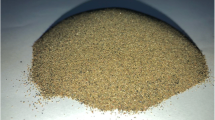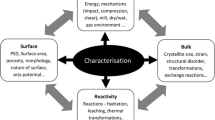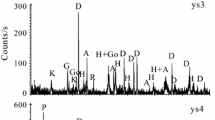Abstract
In this manuscript, we report the analysis of eight uranium ore concentrates (UOCs) from three operating Australian uranium mines using thermogravimetric analysis to investigate whether the thermal decomposition of these UOCs can be used to differentiate between sources. Micro-Raman spectroscopy and X-ray diffraction were also used to identify the different phases present within the original UOC material, as well as chart their decomposition with the increasing temperature. UOCs of different species were able to be differentiated from one another, while the moisture content, a variable component within the UOCs, did distinguish between U3O8 samples sourced from Ranger and Olympic Dam. The effect of elevated temperatures on the diverse UOC morphologies of the three UOCs was also examined.






Similar content being viewed by others
References
VERTIC (2012) Illicit trafficking of nuclear and other radioactive material: the legislative response. London
IAEA (2015) Incidents of nuclear and other radioactive material out of regulatory control—2015 Fact Sheet IAEA, Vienna
Mayer K (2013) Expand nuclear forensics. Nature 503:461–462
Mayer K, Wallenius M, Varga Z (2013) Nuclear forensic science: correlating measurable material parameters to the history of nuclear material. Chem Rev 113(1):884–900
Varga Z, Ozturk B, Meppen M, Mayer K, Wallenius M, Apostolidis C (2011) Characterisation and classification of uranium ore concentrates (yellow cakes) using infrared spectrometry. Radiochim Acta 99:807–813
Varga Z, Katona R, Stefanka Z, Wallenius M, Mayer K, Nicholl A (2010) Determination of rare-earth elements in uranium-bearing materials by inductively coupled plasma mass spectrometry. Talanta 80(1):1744–1749
Varga Z, Wallenius M, Mayer K (2010) Origin assessment of uranium ore concentrates based on their rare-earth elemental impurity pattern. Radiochim Acta 98:771–778
Varga Z, Wallenius M, Mayer K, Keegan E, Millet S (2009) Application of lead and strontium isotope ratio measurements for the origin assessment of uranium ore concentrates. Anal Chem 81:8327–8334
Keegan E, Richter S, Kelly I, Wong H, Gadd P, Kuehn H, Alonso-Munoz A (2008) The provenance of Australian uranium ore concentrates by elemental and isotopic analysis. Appl Geochem 23(4):765–777
Krajko J, Varga Z, Yalcintas E, Wallenius M, Mayer K (2014) Application of neodymium isotope ratio measurements for the origin assessment of uranium ore concentrates. Talanta 129:499–504. doi:10.1016/j.talanta.2014.06.022
Keegan E, Wallenius M, Mayer K, Varga Z, Rasmussen G (2012) Attribution of uranium ore concentrates using elemental and anionic data. Appl Geochem 27(1):1600–1609
Kennedy AK, Bostick DA, Hexel CR, Smith RR, Giaquinto JM (2013) Non-volatile organic analysis of uranium ore concentrates. J Radioanal Nucl Chem 296:817–821
Klunder G, Plaue J, Spackman P (2013) Application of visible/near-infrared reflectance spectroscopy to uranium ore concentrates for nuclear forensic analysis and attribution. Appl Spectrosc 67(9):1049–1056
Plaue J, Klunder G, Hutcheon I (2013) Near intrared reflectance spectroscopy as a process signature in uranium oxides. J Radioanal Nucl Chem 296(1):551–555
Lin DHM, Manara D, Varga Z, Berlizov A, Fanghanel T, Mayer K (2013) Applicability of Raman spectroscopy as a tool in nuclear forensics for analysis of uranium ore concentrates. Radiochim Acta 101(12):779–784. doi:10.1524/ract.2013.2110
Han S-H, Varga Z, Krajko J, Wallenius M, Song K, Mayer K (2013) Measurement of the sulphur isotope ratio (34S/32S) in the uranium ore concentrates (yellowcakes) for origin assessment. J Anal At Spectrosc 28:1919–1925
Manna S, Karthik P, Mukherjee A, Banerjee J, Roy SB, Joshi JB (2012) Study of calcinations of ammonium diuranate at different temperatures. J Nucl Mater 426(1–3):229–232. doi:10.1016/j.jnucmat.2012.03.035
Woolfrey JL (1974) Surface area changes during the calcination of ammonium uranate. Australian Atomic Energy Commission, Lucas Heights
Raje N, Ghonge DK, Rao G, Reddy AVR (2013) Impurity characterization of magnesium diuranate using simultaneous TG-DTA-FTIR measurements. J Nucl Mater 436(1–3):40–46. doi:10.1016/j.jnucmat.2013.01.289
Sato T (1976) Thermal-decomposition of uranium peroxide hydrates. J Appl Chem Biotech 26(4):107–213
Eloirdi R, Lin DHM, Mayer K, Caciuffo R, Fanghanel T (2014) Investigation of ammonium diuranate calcination with high-temperature X-ray diffraction. J Mater Sci 49(24):8436–8443. doi:10.1007/s10853-014-8553-0
Wotherspoon A, Vance L, Davis J, Hester D, Gregg D, Griffiths G, Karatchevtseva I, Zhang Y, Palmer T, Keegan E, Blagojevic N, Loi E, Hill D, Reinhard M (2014) Investigating macro- and micro-scale materials provenancing signatures in uranium ore concentrates/yellowcake. Paper presented at the International Conference on Advances in Nuclear Forensics: Countering the Evolving Threat of Nuclear and other Radioactive Material out of Regulatory Control. Vienna, Austria
Marten H (2006) Environmental management and optimization of in-situ leaching at Beverley. In: Uranium in the Environment: Mining Impact and Consequences. Springer, Berlin. doi:10.1007/3-540-28367-6_54
ERA (2013) Uranium processing at Ranger—information sheet. Darwin
IAEA (1993) Uranium extraction technology. Technical report series, vol 359. Vienna
McKay AD, Miezitis Y (2001) Australia’s uranium resources, geology and development of deposits mineral resources report 1
Yahia M, ElFekey S, ElRazek A (1996) The impact of ammonium and nitrate impurities on the formation of uranium oxides, in the composition range UO3–U3O8-z, during thermal decomposition of ammonium uranates. Radiochim Acta 72(4):205–208
Sato T (1963) Preparation of uranium peroxide hydrates. J Appl Chem 13(8):361–365. doi:10.1002/jctb.5010130807
Thein SM, Bereolos PJ (2000) Thermal stabilisation of 233-UO2, 233-UO3 and 233-U3O8. Oak Ridge National Laboratory, Oak Ridge
Hoekstra HR, Siegel S (1961) The uranium-oxygen system: U3O8–UO3. J Inorg Nucl Chem 18:154–165. doi:10.1016/0022-1902(61)80383-7
Sweet L, Reilly D, Abrecht D, Buck E, Meiser D (2013) Spectroscopic studies of the several isomers of UO3. Pacific Northwest National Laboratory, Richland
Acknowledgments
The authors would also like to acknowledge the financial assistance provided by the Australian Institute of Nuclear Science and Engineering Research Grant (15011) and the Australian Institute of Nuclear Science and Engineering Research Fellowship (Popelka-Filcoff). The authors would like to thank Dr Jonathan Campbell, Dr Cameron Shearer, Dr Ashley Slattery (Flinders University) and Dr Gordon Thorogood (ANSTO) for their assistance, as well as acknowledge the facilities of the Australian Microscopy and Microanalysis Research Facility at the School of Chemical and Physical Sciences, Flinders University.
Author information
Authors and Affiliations
Corresponding author
Rights and permissions
About this article
Cite this article
Ditcham, T., Wotherspoon, A., Kirkbride, K. et al. Thermal decomposition of Australian uranium ore concentrates: characterisation of speciation and morphological changes following thermogravimetric analysis. J Radioanal Nucl Chem 310, 725–732 (2016). https://doi.org/10.1007/s10967-016-4871-9
Received:
Published:
Issue Date:
DOI: https://doi.org/10.1007/s10967-016-4871-9




